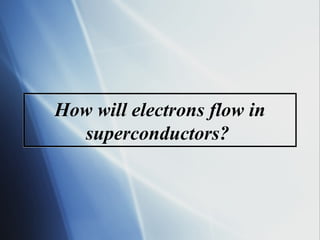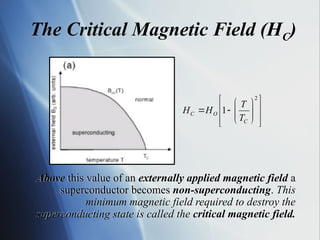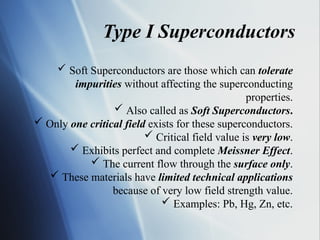presentation on superconductors materials.ppt
- 1. Superconductors Crisanta U. Ganado MST Physics
- 2. Superconductors Superconductors are the material having almost zero resistivity and behave as diamagnetic below the superconducting transiting temperature. Superconductivity is the flow of the electric current without resistance in certain metals, alloys, and ceramics at temperatures near absolute value.
- 3. The Discovery Superconductivity was first discovered in 1911 by the Dutch physicist, Heike Kammerlingh Onnes.
- 4. The Discovery Onnes felt that a cold wire's resistance would dissipitate. This suggested that there would be a steady decrease in electrical resistance, allowing for better conduction of electricity.
- 5. Resistance in a Conductor
- 7. The Discovery Onnes passed a current through a very pure mercury wire and measured its resistance as he steadily lowered the temperature. Much to his surprise there was NO RESISTANCE at 4.2K.
- 9. The Discovery At some very low temperature point, scientists felt that there would be a leveling off the resistance reached some ill-defined minimum value allowing the current with little or no resistance.
- 10. At 4.2 K, the electrical resistance (opposition of a material to the flow of electrical current through it) vanished. Meaning, extremely good conduction of Electricity - Conductivity. Superconductivity
- 11. How will electrons flow in superconductors?
- 12. The superconducting state is defined by the three very important factors: 1.Critical Temperature (Tc) 2.Critical Magnetic Field (Hc) 3.Critical Current Density (Jc) Important Factors to Define a Superconducting State
- 13. This is the critical temperature at which the resistivity of a superconductor goes to zero. Above this temperature the material is non-superconducting, while below it, the material becomes superconducting. The Critical Temperature (TC)
- 14. The temperature which a material electrical resistivity drops to absolute zero is called the Critical Temperature or Transition Temperature. Below Critical temperature, material is said to be superconducting and above this it is said to be in normal state. Below this temperature, the superconductors also exhibits a variety of several astonishing magnetic and electrical properties. The Critical Temperature (TC) Metal Tc (K) Aluminum 1.2 Tin 3.7 Mercury 4.2 Niobium 9.3 Niobium- Tin 17.9 Tl-Ba-Cu- oxide 125
- 15. Above this value of an externally applied magnetic field a superconductor becomes non-superconducting. This minimum magnetic field required to destroy the superconducting state is called the critical magnetic field. The Critical Magnetic Field (HC) 2 1 C O C T T H H
- 16. The scientific notation representing the "critical current density" or maximum current that a superconductor can carry without becoming non-superconductive. For superconductors, maximum critical current density is when the current density is strong enough to quench the superconducting state. The Critical Current Density (JC)
- 17. Electrical Resistance: Virtually zero electrical resistance. Effect of Impurities: When impurities are added to superconducting elements, the superconductivity is not loss but the Tc is lowered. Effects of Pressures and Stress: Certain materials exhibits superconductivity on increasing the pressure in superconductors, the increase in stress results in increase of Tc value. General Properties of Superconductors
- 18. Isotope Effect: The critical or transition temperature T c value of a superconductors is found to vary with isotopic mass. The transition temperature is inversely proportional to the square root of isotopic mass of single superconductors. Magnetic Field Effect: If strong magnetic field applied to a superconductors below its Tc , the superconductors undergoes a transition from superconducting state to normal state. General Properties of Superconductors
- 19. Types of Superconductors Type I T < TC Type II T > TC
- 20. Type I Superconductors Type I: Low TC Superconductors (Superconducting State) T < TC Superconductors that require liquid helium coolant are called low temperature superconductors. Liquid helium temperature is 4.2 K above absolute zero.
- 21. Exhibiting diamagnetic properties to the total exclusion of all magnetic fields. (Named for Walter Meissner.) This is a classic hallmark of superconductivity and can actually be used to levitate a strong rare-earth magnet. The Meissner Effect “The complete expulsion of all magnetic field by a superconducting material.”
- 22. Magnetic Levitation, maglev, or magnetic suspension is a method by which an object is suspended with no support other than magnetic fields. Magnetic force is used to counteract the effects of the gravitational and any other accelerations. The two primary issues involved in magnetic levitation are lifting force: providing an upward force sufficient to counteract gravity, and stability: insuring that the system does not spontaneously slide or flip into a configuration where the lift is neutralized. The Magnetic Levitation
- 23. The levitation of a magnet above a cooled superconductor, the Meissner Effect. The Magnetic Levitation
- 24. Type I Superconductors Soft Superconductors are those which can tolerate impurities without affecting the superconducting properties. Also called as Soft Superconductors. Only one critical field exists for these superconductors. Critical field value is very low. Exhibits perfect and complete Meissner Effect. The current flow through the surface only. These materials have limited technical applications because of very low field strength value. Examples: Pb, Hg, Zn, etc.
- 25. Type II Superconductors Type II: HighTC Superconductors (Normal State) T > TC Superconductors having their TC values above the temperature of liquid nitrogen (77K) are called the high temperature conductors.
- 26. Type II Superconductors Hard superconductors are those which cannot tolerate impurities, the impurity affects the superconducting material. Also called as Hard Superconductors. Two critical fields: HC1 (lower) and HC2 (upper). Critical field value is very high. Don't exhibit perfect and complete Meissner Effect. It is found that current flows throughout the material. These materials have wider technology of very high field strength value. Example: Nb3Ge, Nb3Si.
- 27. Applications Magnetically Levitated Vehicles (MagLev Vehicles) Based on two techniques: Electromagnetic Suspension and Electrodynamic Suspension In EMS, the electromagnets installed on the train bogies attract the iron nails. The magnets wrap around the iron and attractive upward force is lift the train. In EDS levitation is achieved by creating a repulsive force between the train and guide ways. The basic idea of this is to levitate it with magnetic fields so that there is no physical contact between the trains and guideways. Consequently, the maglev train can travel at high speed of 500 km/h.
- 28. Applications Military: Sea Minesweeping Applications The Advanced Lightweight Influence Sweep System (ALISS) contains a 5 ft diameter superconducting magnet built by General Atomics, and is shown below mounted on a high speed Navy Test craft. The system has successfully demonstrated effective and reliable magnetic mine countermeasures.
- 29. Applications Particle Accelerators Superconducting electromagnets have many exciting uses; application in particle accelerators. Particle accelerators where the charged particle travels in a circular path require a strong magnetic field to bend the particle. LHC Cryodipole: A computer generated diagram of a dipole magnet section of the beam-line at the LHC, indicating the use of superconductors. Magnetic Field: The magneti field produced by the LHC dipole's superconducting coils.
- 30. Applications MRI: Magnetic Resonance Imaging MRI systems use a superconducting magnet, which consists of many coils or windings of wire through which a current of electricity is passed, creating a magnetic field of up to 2.0 tesla. Maintaining such a large magnetic field requires a good deal of energy, which is accomplished by superconductivity, or reducing the resistance in the wires to almost zero.
- 31. Particle Accelerators Electric Motors Military Computing Medical Transportation Generators Power Transmission B-Field Detection (SQUIDS) Applications And many more...
- 33. Superconductors Crisanta U. Ganado MST Physics
































